Black Mirror 3 – Review
by Lorna
|
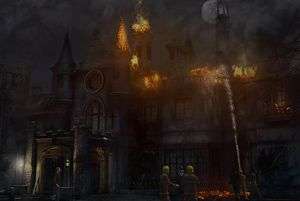 After eight years, two developers, and three games, the last part of the Black Mirror trilogy has wound to a close and I can’t help but feel that it represents a sad day for the adventure genre. The Black Mirror titles rest at the high end of the point and click scale, with Black Mirror 3 being, with its predecessor, at the apex of 2.5D adventures – flawed gems in a maligned, now sadly niche genre. Black Mirror 3 wastes no time in its opening moments, dropping the player into the shoes of Darren Michaels, or Adrian Gordon as we should now refer to him, and sending them headfirst into the action, mere minutes after the cliff-hanger close of the second game.
After eight years, two developers, and three games, the last part of the Black Mirror trilogy has wound to a close and I can’t help but feel that it represents a sad day for the adventure genre. The Black Mirror titles rest at the high end of the point and click scale, with Black Mirror 3 being, with its predecessor, at the apex of 2.5D adventures – flawed gems in a maligned, now sadly niche genre. Black Mirror 3 wastes no time in its opening moments, dropping the player into the shoes of Darren Michaels, or Adrian Gordon as we should now refer to him, and sending them headfirst into the action, mere minutes after the cliff-hanger close of the second game.
While its predecessor enjoyed a leisurely opening act, no such allowance is made here and Adrian runs through the White Woods, burning torch in hand, fleeing the mysterious order who dogged him previously, only to find Black Mirror Castle in flames and the police waiting. He is promptly arrested and jailed on suspicion of arson and murder, and left plagued by nightmares and violent visions.
The game deals with the previous story in a smart way, utilising dialogue, police investigations, and Adrian’s therapy sessions with Dr Winterbottom to bring the new gamer up to date and neatly re-cap for returning players. It didn’t feel force fed or like an exposition overload, which was most welcome – if only the game had played this way five acts later – and overall, felt very natural. After being bailed out by an anonymous benefactor, Adrian is left to roam the small town of Willow Creek, desperate to prove his innocence. Of course, nothing is that simple, and the threads of the second game snake through the narrative, with the fabled curse of the Gordons laying heavily on Adrian’s existence and very sanity as he seeks to unravel it once and for all.
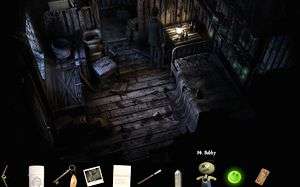 With just over a year between the second and third parts, Black Mirror 3 has seen little change to its solid engine and gameplay mechanics. The HUD remains stealthy, with the inventory and menu options only making themselves known when the screen is edged, and the keyboard shortcuts and pre-death auto-save function are still in place. The interaction is smooth, with inventory items simple to combine or use, and on screen hotspots once more utilise, what has thankfully become, that welcome genre staple, the ‘show all hotspots’ key, which will instantly tag every object, person, or place that can be interacted with.
With just over a year between the second and third parts, Black Mirror 3 has seen little change to its solid engine and gameplay mechanics. The HUD remains stealthy, with the inventory and menu options only making themselves known when the screen is edged, and the keyboard shortcuts and pre-death auto-save function are still in place. The interaction is smooth, with inventory items simple to combine or use, and on screen hotspots once more utilise, what has thankfully become, that welcome genre staple, the ‘show all hotspots’ key, which will instantly tag every object, person, or place that can be interacted with.
Adrian’s diary also makes a welcome return, offering an overview of his thoughts, current tasks, and story threads, all faithfully themed to the journal style that was introduced in Black Mirror 2. Whereas the second game utilised a postcard as an innovative fast travel device, BM3 sees an ordnance survey map put to equally good use, offering swift and effective travel to the many locations in and around Willow Creek, and even becoming part of a puzzle in itself at one point – something I found to be a great touch.
Of course the puzzles, along with interaction and story, are a core point and click essential, and it’s here that Black Mirror 3 begins to stride away from the second title. A good mix of inventory based puzzles and larger main/close-up problems populate the game, and are well designed, logical, and in keeping with the story. Gone are the numerous safes of Black Mirror 2 and, thankfully, the dreaded sliding piece problems are nowhere to be found. The inventory puzzles are smart, logical, and rarely ever obtuse, while the close up problems are varied and genuinely interesting. A particular standout was matching up a handful of names to their respective gravestones, utilising what you’ve been able to observe or glean about the sad inhabitants. Equally, some inventory puzzles especially stood out, such as moving a giant stone with the use of some smart physics. There are no surreal oddities to be found here, and while some problems may have the player dabbing around in a process of elimination, it is likely because they have missed picking up an item at some point, rather than the game being awkward.
While puzzles represent a key aspect of point and click adventures, they are also one of the greatest dangers, with their symbiotic relationship with the story often becoming unbalanced, leading to the ruination of the narrative. Badly designed puzzles can frustrate players and hamper the story, killing the pace and evaporating all tension and it can be a fine line to walk. Thankfully, this is an area in which Black Mirror III improves upon its predecessor – and, indeed, many in its genre – and it seems to have struck a good balance. In the first five acts, the puzzles keep a respectful pace and place within the story without oversaturating it, allowing a healthy momentum in which the two flourish – which is why I wonder quite what went wrong with act six. In building to a crescendo, the final act will always be the most action packed, however, with the story also making a break for the endgame, the puzzles have to be sensitive to this and not snarl up the pace, while simultaneously upping their own game. With this in mind, the latter part of Black Mirror 3’s last act gets somewhat tangled up, with a series of large puzzles and close-up problems coming far more densely packed than the relatively relaxed preceding chapters.
 |
 |
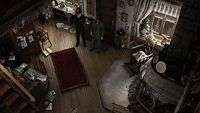 |
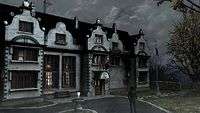 |
 |
 |
This latter stage hides one of the game’s more ingenious and complicated puzzles: a section of catacombs, with connected lights and sliding doors which are crucial to being able to navigate past the sinister shades who inhabit the network of rooms. It has the potential to be very frustrating, but I had to admire not only the inventiveness and ingenuity, but also the tension that was prevalent throughout. Just woe betide you if, as I did, you miss an item in this area. In addition, it seems to be the one large puzzle for which there is no panic trigger. This handy gizmo is a switch that appears after you’ve been stuck for a certain amount of time, allowing you to skip a large puzzle altogether. It’s perfect if you’ve hit a dead end and is a smart addition that will undoubtedly help prevent gamers from abandoning the story should they be unable to find a solution.
Hot on the heels of this particular puzzle came another ‘biggie’, a smaller puzzle, and then perhaps the most irritating thing the game threw at me (and which I sadly saw coming the moment I found the item). It was literally moments before the end, before the whole trilogy is brought to a close, and where tension should be high and hearts racing – instead I was messing about with an especially fiddly puzzle. In other circumstances, perhaps two hours prior to the ending, it would have been a great addition. It wasn’t just the timing, however… many pieces looked identical and their placement was problematic, with no way of knowing if they had been correctly locked into place. Overall though, the puzzles are a strength; the only issues I found, aside from the aforementioned one, were during the dig site location puzzle: the game didn’t align the markings properly, making it problematic to solve, even when the solution was clear.
As with the puzzle elements (more so, in all honesty), the story and those who populate it are very much key and Black Mirror 3, as in the case of its kin, boasts a strong narrative with various sub-plots (though minus the mass of twists of the first two games) and numerous engaging characters.
Speaking of our sarcastic Bostonian protagonist, he has undergone something of a change (unsurprising, considering). While still sarky, Adrian has a haunted air, at times seeming almost resigned to his impending fate, in between bursts of desperation. The violent flashes of his inner passenger torment him, but offer some great character moments as he lets rip at those who have crossed him. This doesn’t help his situation however, since, despite little evidence, his reputation precedes him. Old ladies back away from him and a shop assistant is terrified at his casual examination of knives in a local store – also making for some great moments of dark comedy (especially when you go back to look at them later).
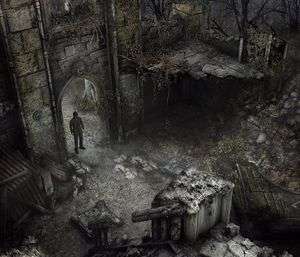 To be honest, Adrian has reason to be angry and frustrated. There has been a cover up of events from the second game, with no trace of anything or anyone to back up his story. It appears that the mysterious order brought more than a bottle of Cif with them to the party and even the bunker where you spent much of your time in BM2 bears no evidence of murder or mystery. Having previously cut through most of the cast (as tends to happen) new faces are needed, and this time out they include the pissed off Inspector Spooner, and therapist Dr. Winterbottom, both of whom provide extra layers to the story, along with butler-in-the-making, Edward, and Lucius Malfoy-alike, Denise. The supporting cast are well realised enough to be engaging, helping the remaining characters to (literally) flesh out Willow Creek once again.
To be honest, Adrian has reason to be angry and frustrated. There has been a cover up of events from the second game, with no trace of anything or anyone to back up his story. It appears that the mysterious order brought more than a bottle of Cif with them to the party and even the bunker where you spent much of your time in BM2 bears no evidence of murder or mystery. Having previously cut through most of the cast (as tends to happen) new faces are needed, and this time out they include the pissed off Inspector Spooner, and therapist Dr. Winterbottom, both of whom provide extra layers to the story, along with butler-in-the-making, Edward, and Lucius Malfoy-alike, Denise. The supporting cast are well realised enough to be engaging, helping the remaining characters to (literally) flesh out Willow Creek once again.
Sound has always been a strength of the series, and here it is the same. Mournful strings and piano combine to evoke a haunting reflection of the town and family beset by tragedy, offering brassy punctuation for effect where necessary without ever overwhelming or becoming obtrusive. It perfectly complements the story and themes, working with the beautiful audio effects to sustain a vivid atmosphere. Birds caw in the background, a stream babbles through the White Woods; at the lighthouse, waves throw themselves endlessly against the rocks, while in town, freezers grind and clank with age, and barking dogs and burping water coolers create a broad, textured backdrop of sound. A few small niggles with misplaced effects aside, they were a resounding success. Something which sadly can’t be said of the voice acting.
The greatest failing of many adventure games and one of the few of Black Mirror 2’s flaws that ‘three’ fails to fix, is the voice acting. Once again, it surpasses most others in the genre with some solid performances, but is still a rather chequered selection, veering from excellent, to awful. For the most part, the regular voices are fine, with Lady Victoria, the doc, and Murray being standouts, but when the game dips into accents, things get dicey. Irish and something approaching Scottish are wince-worthy in varying degrees and, while forgivable in the greater scheme of things, are ultimately a let-down. My greatest concern was that the worst of these was one of the new characters who is prevalent in the game’s opening scenes, potentially putting off any genre newcomers who try the demo, and who can’t or won’t forgive this common flaw enough to continue.
Not only is the audio a standout, but the visuals are striking. The 2.5D nature of the game allows for some truly exquisite backdrops to be created. This time, there is no sleepy American seaside town, no castle in Wales, just Black Mirror Castle and the Willow Creek area. While the game feels somewhat claustrophobic in comparison to the second, it adds to the overall atmosphere of tension and entrapment. It helps that Cranberry Production have clearly met the challenge to keep old locations fresh, changing enough while paying tribute to the previous titles at the same time.
Fans will be pleased to see many familiar places return with a new twist, with many from the first game cropping up with a sexy new lick of paint and perspective, including the sinister morgue and the fateful stone circle. The setting of Willow Creek is an effective one and this quintessentially English town, dogged by tragedy, is painted with a finely detailed brush, with the collection of buildings often boasting more character than some of the locals.
The overstuffed village store is full of baskets of produce and shelves full of essentials, while the familiar Gordon’s Palace Hotel drips with pretentious, undeserving grandeur; white columns, and gold luggage trolleys cater to those discerning, ghoulish tourists lured by the town’s resident ambulance chaser and purveyor of sick, opportunistic tat – Murray. Even the remains of the castle are stunning, with the sooty façade swaddled in scaffolding, its towers and stoic windows remaining defiant in the face of destruction, presenting a sad, imposing presence. Measured against Murray’s hotel, the castle reveals a true, if broken, opulence in its damaged innards, tempered by the spectre of death and the long history which seems to be infused in every brick and decorative tile. Here the game’s visual details leap out, from coats of arms, to the jumble of paintings, shelves of old books, and salvaged clutter. It was fascinating to wander through damaged locations, where your character had been mere weeks before and see the transformation offered by the developers. The old kitchen is now a collapsing, blackened mess, while the grand hall is a construction site of rubble and missing tiles. It has a sad beauty to it and the themes of hope and renewal among devastation and death are common throughout the game, from Black Mirror’s hall, to the struggling town, to Adrian himself.
Taking the time to enjoy every location is worth the time to absorb the sheer scale of detail; the textures of the leather armchair in the hotel room or the cracks in the worn tarmac road in the White Woods are just two small examples. The graveyard at Warmhill was impressive, especially at night, with candles flickering through the low, encroaching mist. In the town, under a downpour, water streamed down the roofs, cascading from downpipes into overflowing barrels. Signs stir in a breeze, old ladies gossip on a bench, and the doc’s cigarette smoulders while a Newton’s Cradles clicks in the background. Above the houses, clouds slide across the sky while flocks of birds pass overhead. Take a look at the dartboard in the police station, see anyone you recognise?
The lighting takes things further still, with pulsing lamps and reflections on tiles or in freezer doors, giving a rarely seen level of detail, while lightning flashes briefly illuminate already eerie scenes, transforming them from quiet to unnerving in seconds.
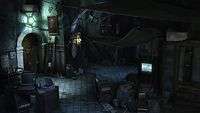 |
 |
 |
 |
 |
 |
The overall atmosphere is beautifully crafted, with every detail, location, and effect, both audio and visual, working in harmony to weave tension and drama and conjure a feeling of weary dejection and overarching sadness. Tumbledown, overgrown, broken, decayed, sad places surround the town and its microcosm of pathos is highly effective in not only communicating the game’s themes, but highlighting Adrian’s fragile state of mind and haunted demeanour as the Gordon family history and curse press steadily more heavy upon him. The incessant drumming rain makes the town itself feel as battered as the protagonist and the dramatic moments punch through the tension at just the right times.
For all the tension and mystery, a welcome seam of dark humour still prevails, with many of the game’s hotspots providing touches of relief in Adrian’s sarcastic appraisal. It is, however, some of the more tragic elements that provide the most humour, mainly in the shape of the loathsome Murray. Returning from the first two titles, Murray is the sleazy hotelier with fewer morals than a mollusc and less compassion and respect for the dead than the average toenail clipping. The sick excuse for a town museum has been upgraded with new, often shockingly tasteless exhibits, further exploiting the murders which have rocked the town over the years, including those of recent events, and there is no low that Murray won’t sink to in pursuit of the tourist pound. It is as amusing as it is distasteful, but the underlying tilt of the lance at the very human trait of the exploitation of tragedy, and people’s, often obsessive, interest in the macabre is a fine one indeed. To counterbalance some of the more sobering exhibits are Murray’s more comical money making schemes, exploiting Adrian’s new status as a suspected murderer. While I won’t spoil them, a few of the trinkets made me laugh out loud, among them the badges reading: “I Love Blood,” and the tasteful: “Take My Soul”.
Overall, the gameplay remains largely the same until act six where it suddenly switches to dual protagonist mechanic. It was an interesting, if very late, element to the gameplay, and I appreciated it more for the fact that it added some interesting touches when examining objects. Although it was effective, with the characters working in harmony to solve some of the larger puzzles, it would better suit a future series; here, its sudden introduction detracted from Adrian, who should have been the sole focus at this stage.
 It has been a long journey to reach this point. Black Mirror III plays things straight, leaving the larger plot twists and contortions to its predecessor and, instead, concentrates filling in some of the intriguing Gordon family history and the origin of the famous curse – catnip to fans. The layers peel back to reveal torture, cruelty, pain, and murder, even beyond the curse, as the game, in these small but striking details, touches on the evil of people, abuse of power, and the ability of that power to corrupt. Themes of destiny and identity rear up as Adrian finds his distaste for his family and the burden of the past at odds with the role he has now been left with.
It has been a long journey to reach this point. Black Mirror III plays things straight, leaving the larger plot twists and contortions to its predecessor and, instead, concentrates filling in some of the intriguing Gordon family history and the origin of the famous curse – catnip to fans. The layers peel back to reveal torture, cruelty, pain, and murder, even beyond the curse, as the game, in these small but striking details, touches on the evil of people, abuse of power, and the ability of that power to corrupt. Themes of destiny and identity rear up as Adrian finds his distaste for his family and the burden of the past at odds with the role he has now been left with.
Through it all, the story is strong, well paced and absorbing, though it wasn’t without flaws which ultimately let it down somewhat. The biblical elements were intrusive, and gave the story a sudden ‘mainstream feel’ out of nowhere which was unnecessary. While it fit the framework of the plot fine, it just felt too obvious somehow. The main character is kept carefully neutral among the religious bumph to avoid alienating the player, but the story would arguably have been just as strong without it, with the plethora of material and ideas in the backstory, locations, and characters surely enough of a font for an alternative.
Throughout the game there was much to enjoy in the fleshing out of the backstory and family history, the more subtle plotting, and gentler pace of puzzles which facilitated the narrative… which is why act six was more disappointing.
It is always odd when a long story comes to an end, but the odd hollow feeling that I was left with had to speak to more than just that. In the closing part, some of the puzzles didn’t help matters, and the locations felt overblown and a touch unrealistic (I’m amazed the whole castle hadn’t collapsed with what lay beneath it), but overall, I just felt oddly underwhelmed. It wasn’t a bad ending and I was relieved, even pleased, but it could have been better. The crude placement of the final puzzle didn’t help, but the whole lead up and change of gameplay mechanic in the final act just seemed to put it off kilter enough that by the end I didn’t feel as fired up as I thought I would have been. This may well have been due to the sudden, massive plot and backstory explanation that was unceremoniously handed out moments before the end, and which necessitated repeated re-reads to fully absorb and understand it before I could reward myself with the ending. Yes, I was happy, but at the same time, a little flat. The post credits extra scene raised my hopes and, while it was a nice touch, it was something of a wasted opportunity… much could have been done here, but instead it was little more than a recap of the previous plot dump. There is a hint of potential for a new series, but it was still more of a comfortable steady tone than a high note.
I rarely sit down to review a game feeling so oddly divided, but that’s how Black Mirror 3 has left me – on one hand, I feel melancholy, because the last curtain has closed, leaving me adrift. On the other hand, I’m also left with a hollow feeling that the end could have been something more, but then perhaps my own internal hype dampened what was an adequate, inoffensive ending (after the outcry after the first two games, the best course of action was likely a safe one). Overall though, it can’t detract from what is an outstanding game. Black Mirror represents the cream of the point and click adventure genre and few games can create an atmosphere to enmesh the player as effectively. Outstanding visuals, beautiful audio, and high level of details breathe incredible life into the game’s locations, helping infuse the story with an unforgettable atmosphere, veering from tension to melancholy. The story, though not without its flaws, is a deep one, with a grand backstory of murder, mystery, and suspense which may not yet be fully plumbed, but which will remain among the best of the genre.
Pros- Represents the high end of 2.5D adventures - few do this better
- Engaging story and characters
- Evocative atmosphere of tension, melancholy, and mystery combines with dark humour to toy with the player's emotions
- Locations are stunning, rich in detail and well realised
- Haunting soundtrack
- The winding history of the Gordons finally unfolds
- Well designed, smart puzzles
- Improves on most of the flaws of the second game
- Full of little audio and visual touches which help breathe life into Willow Creek
- Potential for more?
- The trilogy had to end
- Chequered voice acting
- The last puzzle was a pain, skip it to avoid killing the momentum
- Some alignment mechanics in puzzles was off, making them tricky to solve
- A sizeable plot dump at the last moment stalls the story
- Though satisfying, the ending felt slightly underwhelming
- Some questionable story elements and minor flaws in a few effects and animations
The final part of the Black Mirror Trilogy comes to an end, and with it comes a genuine sense of loss for the genre. While the closing moments were somewhat dulled and interrupted by the last act and a heavy-handed plot dump, the series ends on a high and boasts a solid story, vibrant audio and visual details, and an atmosphere that is second to none. The player’s emotions are plucked with the dexterity of a harpist; strains of dark humour blend seamlessly through the pathos and tragedy, winding among the stifling atmosphere of sadness that enshrouds the town of Willow Creek. Moments of tension give way to shocks, humour dissolves into pauses of reflection, and nostalgia keeps pace with delight at the new.
Let down only by some patchy voice acting, a few gameplay mechanic issues, and some questionable story elements and timing, Black Mirror sets the bar high for those following in its sizeable footsteps. Well designed, evocative, smart, often brilliant, puzzles are well paced, complimenting the story for the most part, rather than killing it, and the smooth interaction mechanics and inventory system of the second game have been retained. Black Mirror III has fixed most of the complaints that I had about Black Mirror II and delivered a solid, enjoyable end to an outstanding series. I shouldn’t be too sad though, as with the breadth of the story that they have created and the scope that remains, perhaps it won’t be the last we’ve heard from Cranberry’s haunting world.
Last five articles by Lorna
- Flagging Heart
- Where Have All the Hours Gone?
- I Heart... Overlord
- Life Goes On: Done to Death - Review
- Welcome to Spoilerville, Please Despise Your Stay




















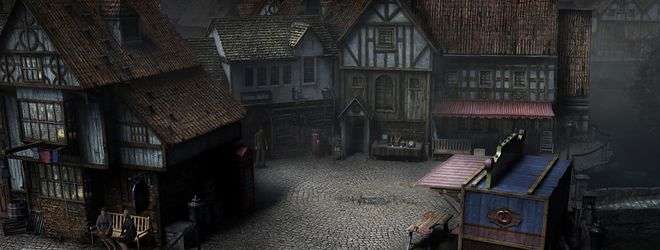

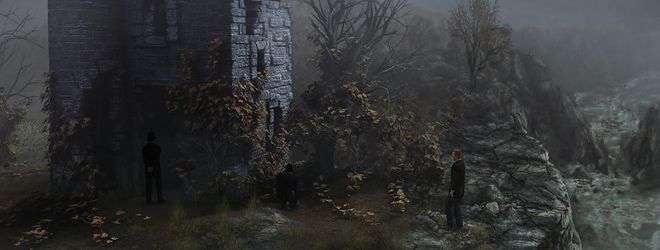






Wow. Stunning review, Lorna. In-depth as always. I’ve not looked at the previous Black Mirror games despite good intentions, and it looks more and more like I’m missing out. I’m going to have to make the effort I think.
Might stick these on my laptop to play through while travelling in a few weeks time. Visually it’s stunning and looks better than quite a few big name releases.
Absolutely drawn in by this review, it’s another stellar job.

Despite the flaws you listed, it still sounds like a potentially fantastic game, and I wish I had time to give the series a shot now. Point and Clicks are a weakness, and if it’s filled with enough humour I can just about forgive the voice acting
I have literally no place in my life for PC adventure pointy clickers and if this was anyone else’s review I wouldn’t even read it. In fact I’d be like *shun!* all at it but when Lorn puts words on a screen I’m a word reading motherfucker. These words were good and pleased me in a way that no pointy clicker ever can.
Fantastic. Your ability to weave such an evocative and rich tapestry of words and conjured images never fails to both draw me in and take my breath away.
I’m just into act two of this game at the moment and loving it. As a loyal fan of the Black Mirror series from the first game all those years ago, I can’t wait for the history of the Gordens, the curse and story’s end to finally be revealed. I just wish there could be a Black Mirror four. Still, never say never, right?
Awesome review Lorna, shame it left you a bit “meh” towards the end. It looks quite hard for me I dunno how I’d get on with it, I’d feel like I was cheating hitting the solve switch all the time (which I would be). I tend to just point at click on everything and then lose my temper when I can’t do things like open an old wooden desk with a flash light.
Christ, that’s in-depth! So… if I had to start at Black MIrror and work my way through the entire trilogy… how long would I need? I said it on the Black Mirror 2 review, and I’ll say it again… I DO want to play these, but my biggest problem right now is time. Once LA Noire is out of the way, and with Crysis 2 on hold for a bit (no particular reason; it just is) I could try and at least get the first game played. I don’t want to be coming to these after they’re long-forgotten gems that we’d class as “retro”… I’d rather tackle them while they’re still cutting edge.
Looks beautiful too, and I think the story could pull me in. SO I’m sold, but I just need to get the timings sorted! Awesome review; so detailed and specific too.
Thank you so very much to everyone who commented, much appreciated. It was a long one to sit down to, but for the end of a very respectable series, which will be sorely missed, I think it was important to do it justice
Anyone who fancies it, I recommend starting with Black Mirror 2 – you’ll be lucky to find BM1 and there is a significant gap between the first and second title that you’ll get past easily. If you find yourself enjoying it, you can always go back and dig up a copy.